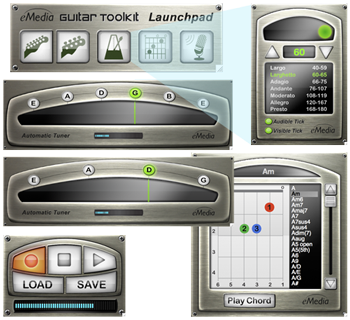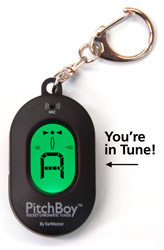A digital guitar tuner makes tuning your guitar easy. Once you learn how to tune a guitar with a digital tuner, you will probably only use this technique as it makes tuning your guitar so much easier. It listens to the note you play on your guitar via a microphone or guitar/line input or by sensing the vibration of the instrument as you play. Then it shows you visually whether the note is in tune. Visual feedback comes in a variety of forms from spinning dials to blinking lights to moving meters. The point of the feedback is always simply to inform you whether the string is in tune or you need to tune it up or down.
Steps for Tuning with a Digital Tuner
- Make sure you know the basics of How to Tune Your Guitar, such as the names of the notes in standard tuning.
- Set up your digital guitar tuner to detect pitch. If you have an electric guitar or electric acoustic, use the tuner line-in if possible to eliminate background noise. Use the method below that matches your tuner and guitar:
LINE-IN: If your tuner features a 1/4″ input jack and your guitar features a pickup and 1/4″ output (all electric guitars and some acoustic guitars), plug an instrument cable between the two and make sure your volume knob is turned up on the guitar (if it has one).
MICROPHONE: If your tuner has a microphone, place the tuner on a table in front of you or on your lap as you hold your guitar. If you have an electric guitar, place it in front of your amplifier. If you are using a software tuner, sit close to your laptop’s built-in microphone or place an external USB microphone in one of the positions already mentioned.
CLIP-ON TUNERS: If your tuner is designed to detect vibration (all clip-on tuners), go ahead and clip it on the guitar headstock (the part of your guitar that has the tuning keys). - Play a guitar string.
- Look at the tuner to see if the string is flat (too low in pitch), sharp (too high in pitch) or in tune.
- Adjust the pitch of the string up or down as indicated by the tuner using the guitar tuning key. Watch the guitar tuner display to make sure you’re adjusting the string in the appropriate direction.
- The tuner will show you when the string is in tune (the string light turns green, a center indicator is illuminated, etc.).
NOTE: It’s important to know which note you’re trying to attempting to tune and the order of the note names. The note names are ordered alphabetically and cycle to the beginning after “G.” In other words, A-B-C-D-E-F-G-A-B-C., etc. Some digital guitar tuners will confirm that you’re in tune, but you could be tuned to a “D” note when you’re attempting to tune the “E” string. You would have to tune up to get to “E.” The eMedia automatic tuner software is unique because it shows you how close you are to the standard tuning notes. This takes any guesswork out of tuning with a digital guitar tuner. Also note that many digital guitar tuners can operate as bass tuners as well. If you need a bass tuner, double check that the model you purchase has this ability.
Types of Digital Guitar Tuners
Software Tuners
 Digital tuners also come as software for Macs, PCs, and mobile devices. For example, eMedia intermediate and beginning guitar lesson software include a wonderful digital guitar tuner, metronome, chord library, and audio recorder, as does their $4.95 eMedia Guitar Toolkit.
Digital tuners also come as software for Macs, PCs, and mobile devices. For example, eMedia intermediate and beginning guitar lesson software include a wonderful digital guitar tuner, metronome, chord library, and audio recorder, as does their $4.95 eMedia Guitar Toolkit.
You can also find guitar tuning apps for mobile devices, such as the iPhone.
Hardware Tuners

Digital tuners can be dedicated hardware devices. For example, the PitchBoy digital tuner in the picture here is a great, basic digital guitar tuner that is only $9.95. It fits on a key chain, and even comes with eMedia Introductory Guitar or eMedia Introductory Bass lesson software. Other hardware tuners are available in many different configurations, from a number of companies.
Chromatic Tuners
Chromatic tuners can detect and display the names of all 12 notes in the Western musical scale (A-A#/Bb-B-C-C#/Db-D-D#/Eb-E-F-F#/Gb-G-G#/Ab) and are also available as hardware or software. Digital guitar tuners with a pitch display are chromatic tuners. Chromatic tuning is useful for tuning your instrument with alternate guitar tunings.
Some chromatic tuners track note ranges much higher and lower than those available on guitars and basses. This is why chromatic tuners are the standard tuner found in a school band or orchestra environment. The screen on the digital tuner might also display the frequency of the note (such as 440 Hz for an A note).